Strategies for Effective Decision Making in Meetings

Introduction
The Importance of Effective Decision-Making in Meetings
In today's fast-paced and competitive business environment, making the right decisions is crucial for the success and growth of any organization. Meetings are often the platform where these critical decisions are made, making it essential to ensure that they are effective and result-oriented. Inefficient meetings not only waste time and resources but can also lead to poor decision-making and unsatisfactory outcomes.
Strategies for Effective Decision-Making in Meetings
In this article, I will explore various strategies to improve decision-making in meetings, ensuring that your organization stays ahead of the curve. By implementing these strategies, you can foster a culture of collaboration and informed decision-making that drives your organization towards success. The key topics that I will cover include:
- Understanding the Decision-Making Process: Get a grasp on the decision-making process in meetings, and learn how to recognize and overcome common biases and pitfalls.
- Establishing Clear Objectives and Agendas: Discover the importance of setting clear objectives and agendas to facilitate effective decision-making, and explore specific strategies for their implementation.
- Encouraging Diverse Perspectives and Active Listening: Learn how diverse perspectives and active listening can improve decision-making, and explore specific strategies to promote them in meetings.
- Implementing a Structured Decision-Making Process: Understand the benefits of a structured decision-making process, and learn how to implement one in your meetings.
- Assessing Risks and Consequences: Learn the importance of risk and consequence assessment in decision-making and explore specific strategies for incorporating them in meetings.
- Analyzing Data and Evidence: Discover how data and evidence analysis can support effective decision-making, and learn how to implement this in your meetings.
- Addressing Conflict and Reaching Consensus: Understand the role of conflict resolution and consensus building in decision-making, and explore specific strategies for their implementation.
Understanding the Decision-Making Process
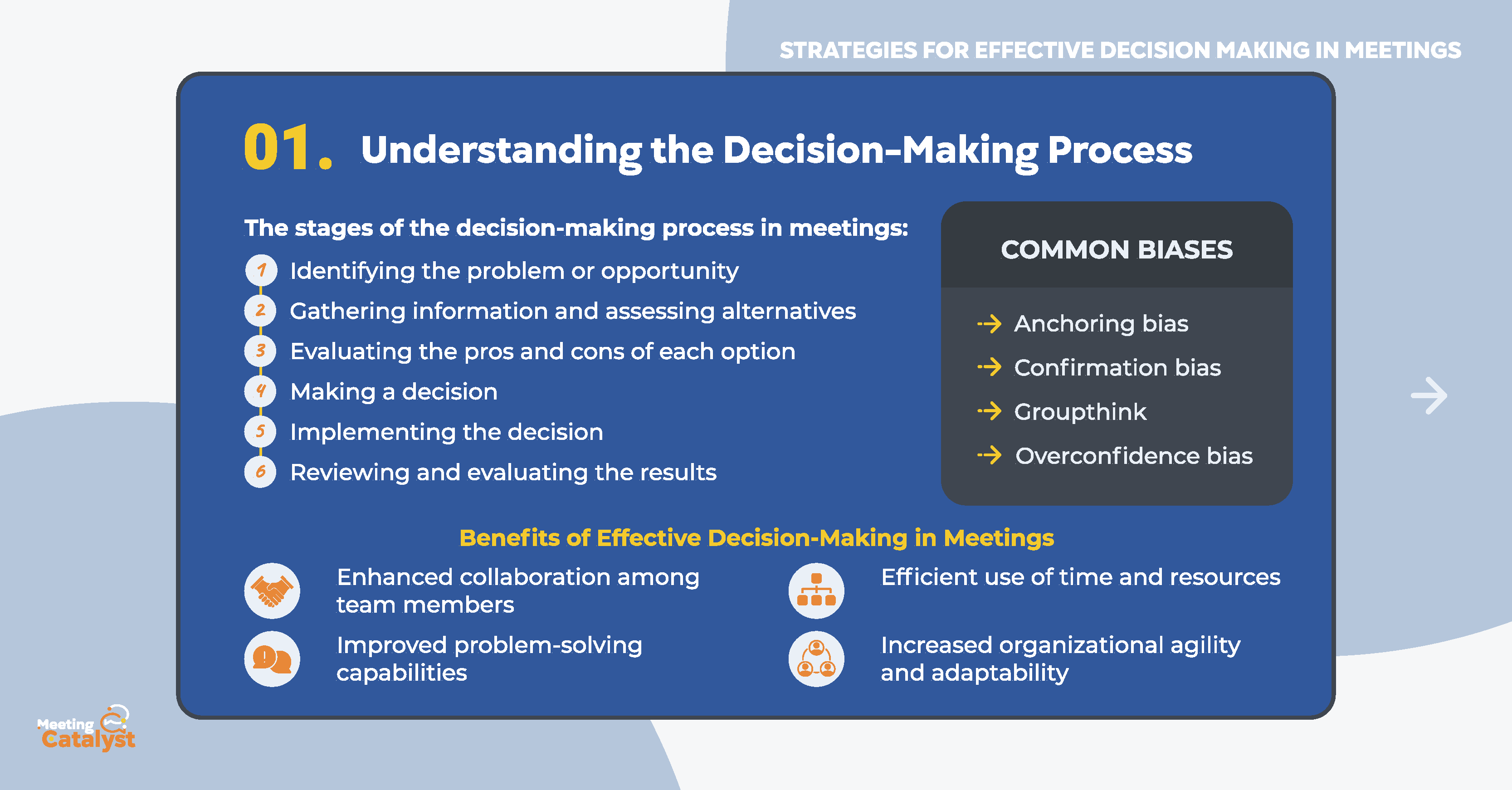
Overview of the Decision-Making Process in Meetings
Effective decision-making is a cornerstone of successful meetings. To fully grasp the intricacies of decision-making, it is essential to understand the process itself. Generally, the decision-making process in meetings consists of the following stages:
- Identifying the problem or opportunity
- Gathering information and assessing alternatives
- Evaluating the pros and cons of each option
- Making a decision
- Implementing the decision
- Reviewing and evaluating the results
Common Biases and Pitfalls Affecting Decision-Making
During the decision-making process, various biases and pitfalls can hinder the effectiveness of decisions. Some common biases include:
- Anchoring bias: Relying too heavily on the first piece of information encountered when making decisions
- Confirmation bias: Seeking out information that confirms pre-existing beliefs, while ignoring contradictory evidence
- Groupthink: The tendency for group members to conform to the dominant opinion, rather than critically evaluating all options
- Overconfidence bias: Overestimating one's ability to predict outcomes, leading to overly optimistic or pessimistic decisions
To mitigate the impact of these biases, it is crucial to:
- Encourage open-mindedness and critical thinking
- Foster a culture where dissenting opinions are welcomed
- Allocate sufficient time for thorough analysis and deliberation
Benefits of Effective Decision-Making in Meetings
Effective decision-making in meetings yields numerous benefits, such as:
- Enhanced collaboration among team members
- Improved problem-solving capabilities
- Efficient use of time and resources
- Increased organizational agility and adaptability
By understanding the decision-making process and recognizing common biases and pitfalls, your organization can make better decisions that drive success and growth.
Establishing Clear Objectives and Agendas
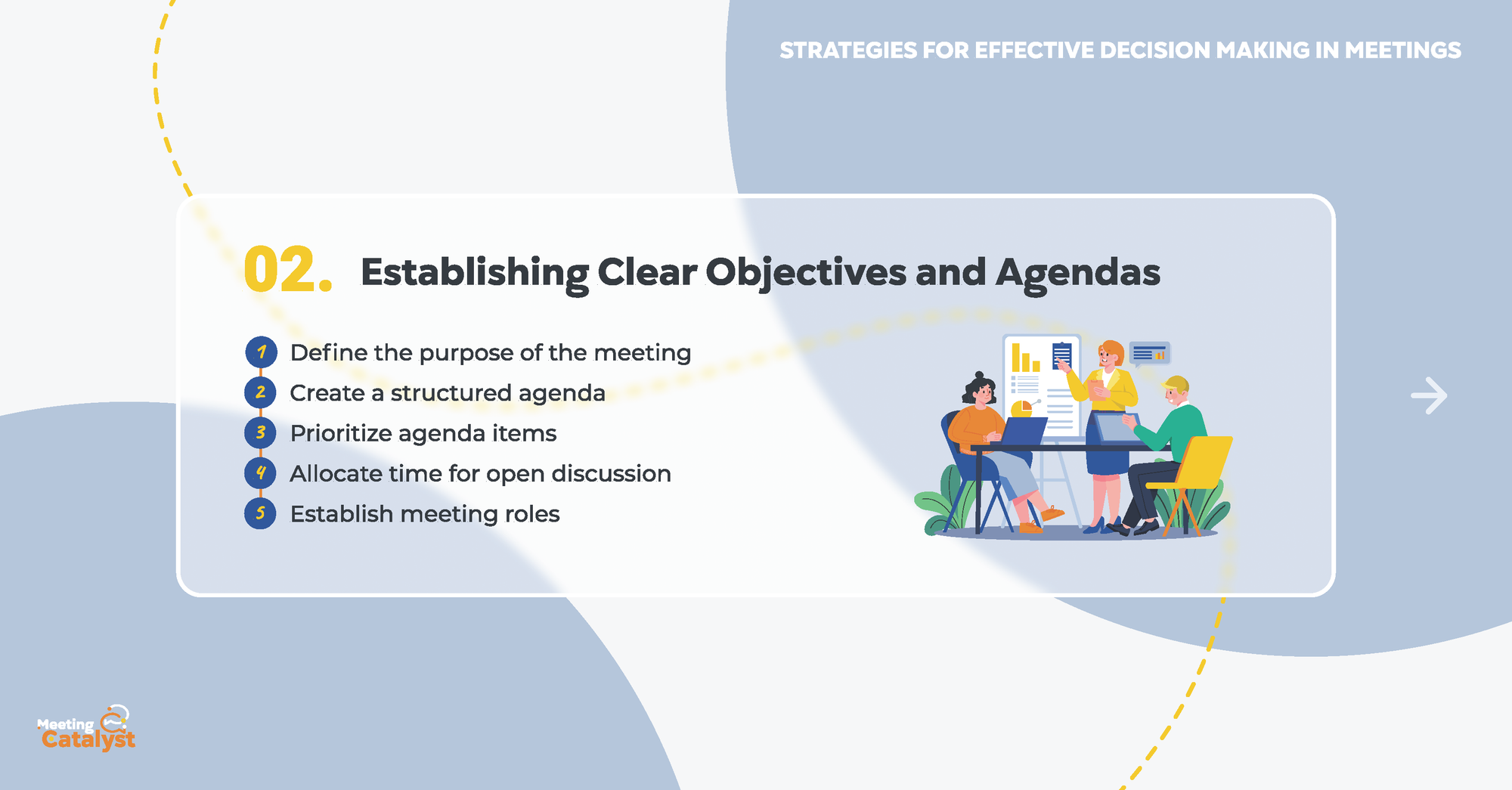
The Role of Clear Objectives and Agendas in Effective Decision-Making
Establishing clear objectives and agendas for meetings is crucial in facilitating effective decision-making. Well-defined objectives and agendas provide a roadmap for discussion, ensuring that meetings stay focused and aligned with organizational goals. Moreover, they enable participants to come prepared, increasing the likelihood of productive discussions and well-informed decisions.
Specific Strategies for Setting Objectives and Agendas
To promote effective decision-making in meetings, consider implementing the following strategies for setting objectives and agendas:
Define the purpose of the meeting: Clearly articulate the purpose of the meeting and the decisions that need to be made. This helps attendees understand the context and expectations, enabling them to contribute more effectively.
Create a structured agenda: Develop a detailed agenda that outlines the topics to be discussed, the allotted time for each topic, and the desired outcomes. Distribute the agenda to participants in advance, allowing them ample time to prepare for the meeting.
Prioritize agenda items: Order agenda items based on their importance, ensuring that critical decisions are addressed early in the meeting when participants are most alert and engaged.
Allocate time for open discussion: Reserve time in the agenda for open discussion, allowing participants to raise concerns or suggestions that may not be covered in the predetermined agenda items.
Establish meeting roles: Assign specific roles to participants, such as facilitator, timekeeper, or note-taker, to keep the meeting on track and ensure that objectives are met.
Remember, establishing clear objectives and agendas is a vital component of effective decision-making in meetings. By adopting these strategies, your organization can enhance collaboration, optimize resource utilization, and make well-informed decisions that drive success.
Encouraging Diverse Perspectives and Active Listening
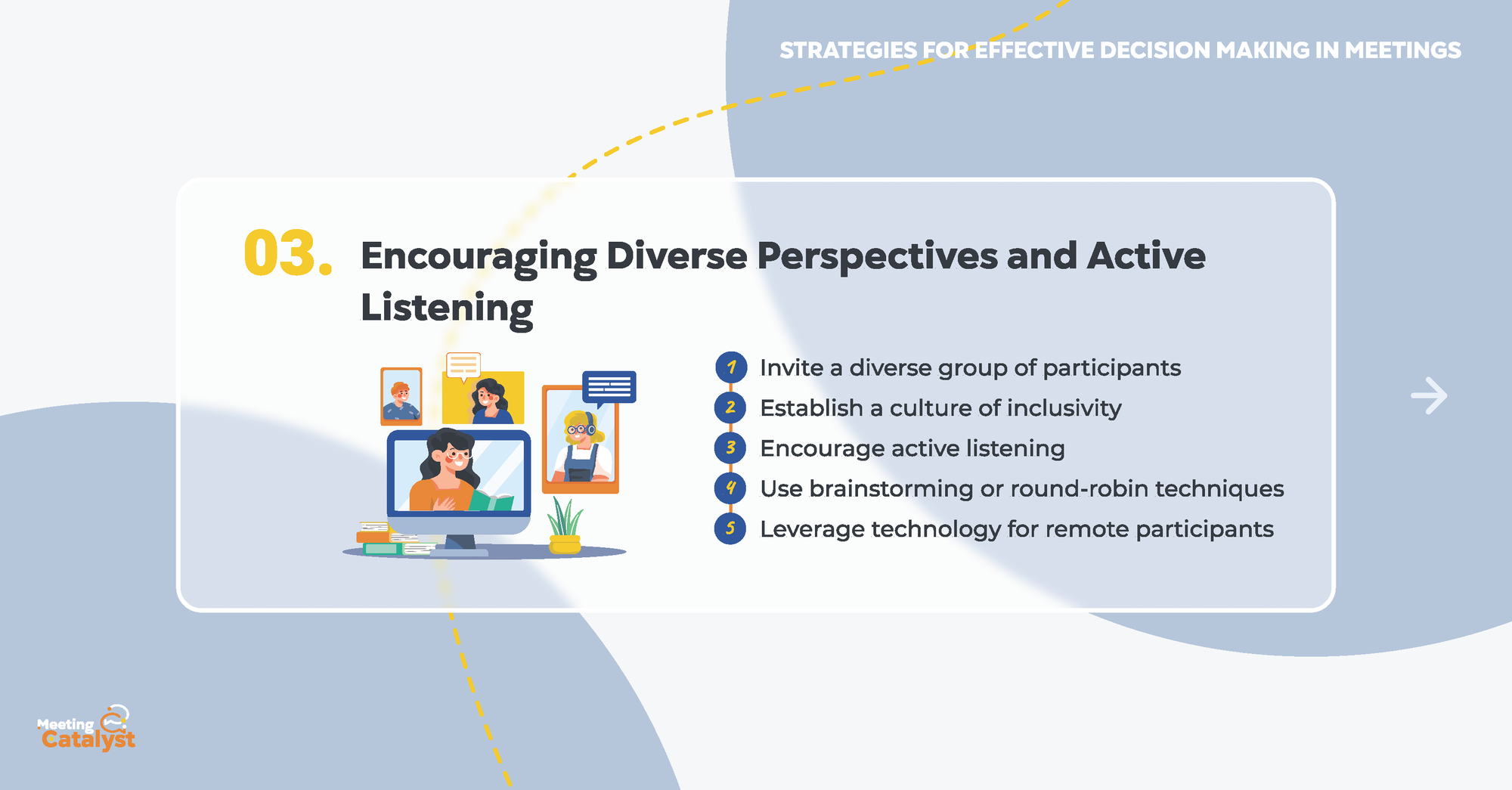
The Impact of Diverse Perspectives and Active Listening on Decision-Making
Encouraging diverse perspectives and active listening in meetings can significantly improve decision-making. Diverse perspectives bring a variety of experiences, ideas, and insights to the table, fostering innovation and reducing the likelihood of groupthink. Active listening, on the other hand, ensures that all participants feel heard and respected, leading to greater collaboration and more informed decisions.
Specific Strategies for Encouraging Diverse Perspectives and Active Listening
To promote diverse perspectives and active listening in decision-making meetings, consider implementing the following strategies:
Invite a diverse group of participants: Ensure that your meeting includes individuals with different backgrounds, experiences, and expertise, allowing for a broad range of perspectives and ideas.
Establish a culture of inclusivity: Create an environment where all participants feel comfortable sharing their opinions and insights, free from judgment or ridicule.
Encourage active listening: Remind participants to practice active listening by giving their full attention to the speaker, refraining from interruptions, and asking clarifying questions when necessary.
Use brainstorming or round-robin techniques: Implement structured discussion methods, such as brainstorming or round-robin, to ensure that everyone has the opportunity to contribute their ideas and perspectives.
Leverage technology for remote participants: Make use of video conferencing and collaboration tools to enable remote participants to contribute effectively and engage in active listening.
By promoting diverse perspectives and active listening in your meetings, you can unlock the full potential of your team and make well-informed decisions that drive your organization's success.
Implementing a Structured Decision-Making Process
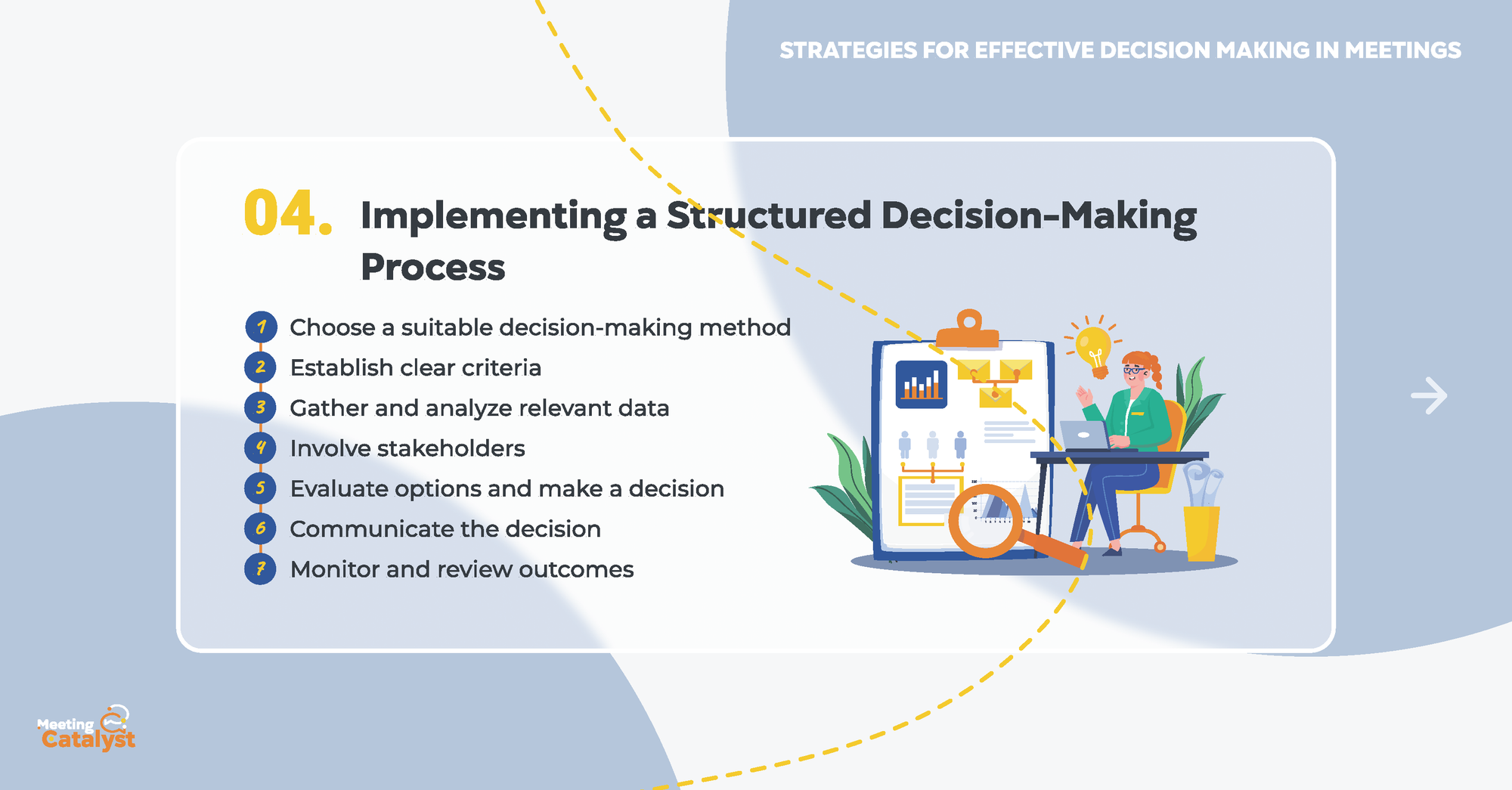
How a Structured Decision-Making Process Enhances Decision-Making
A structured decision-making process can significantly improve the quality and efficiency of decisions made in meetings. By providing a systematic framework for evaluating options and making choices, a structured process minimizes the influence of biases, ensures that all relevant factors are considered, and promotes transparency and accountability in decision-making.
Specific Strategies for Implementing a Structured Decision-Making Process
To implement a structured decision-making process in your meetings, consider the following strategies:
Choose a suitable decision-making method: Select a decision-making method that fits the context and complexity of the decision at hand. Common methods include the pros-and-cons list, decision matrix, and multi-criteria decision analysis (MCDA).
Establish clear criteria: Define the criteria that will be used to evaluate options, ensuring that they align with your organization's goals and values.
Gather and analyze relevant data: Collect data and evidence to inform your decision-making process, and use analytical tools and techniques to assess the available options objectively.
Involve stakeholders: Engage stakeholders in the decision-making process, soliciting their input and feedback to ensure that all perspectives are considered.
Evaluate options and make a decision: Systematically assess the available options based on the established criteria and make a well-informed decision.
Communicate the decision: Clearly communicate the decision to all relevant parties, along with the rationale and supporting evidence, to promote transparency and buy-in.
Monitor and review outcomes: Track the outcomes of the decision and review its effectiveness, adjusting your approach as needed to optimize future decision-making processes.
Implementing a structured decision-making process in your meetings can lead to better-quality decisions, increased efficiency, and a more transparent and accountable decision-making environment. By adopting these strategies, your organization will be better equipped to navigate the complexities of the business world and make well-informed decisions that drive success
Assessing Risks and Consequences
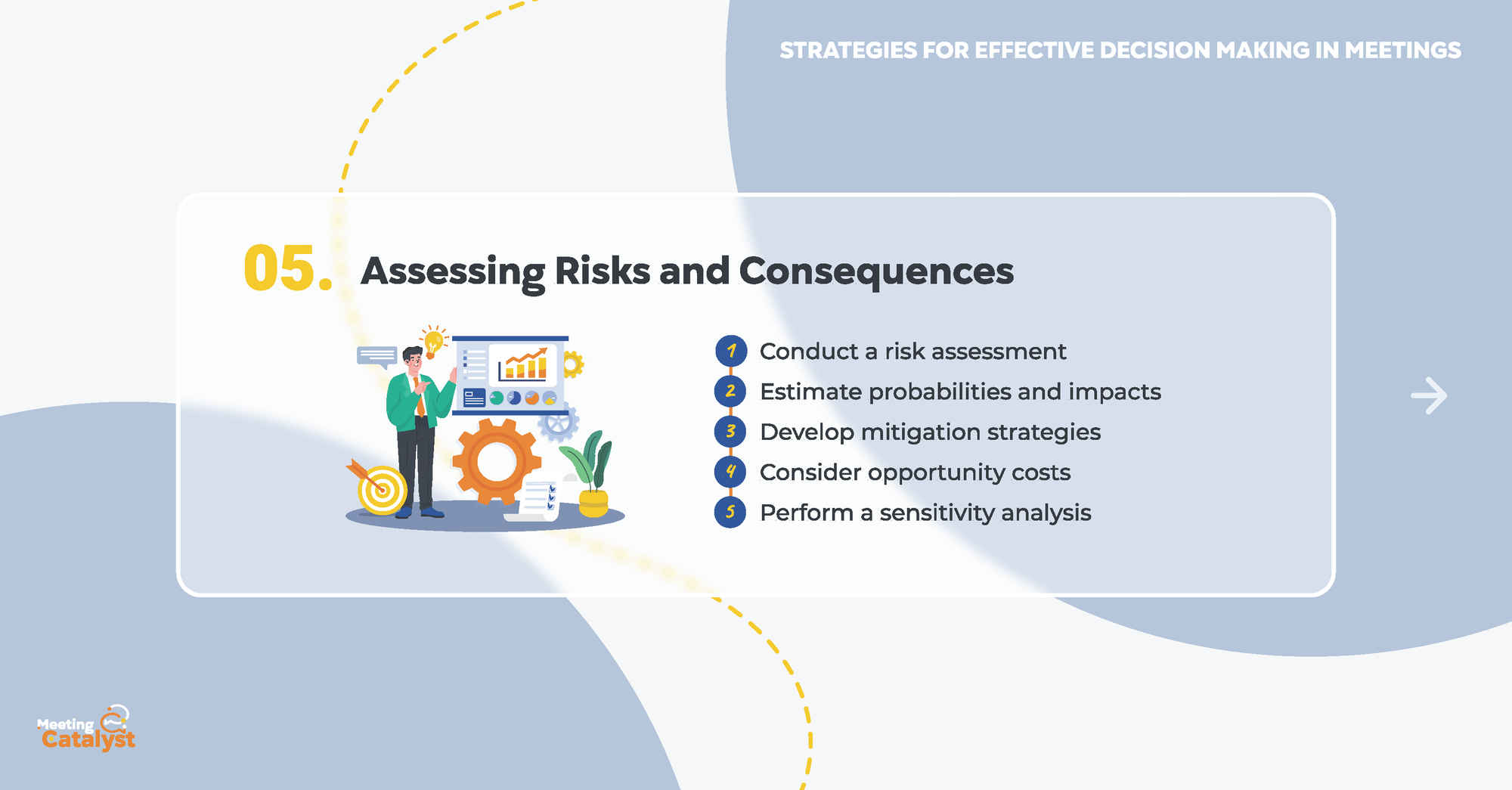
The Importance of Assessing Risks and Consequences in Decision-Making
Assessing risks and consequences is a critical aspect of effective decision-making in meetings. By identifying potential risks associated with each option and evaluating their potential impact, decision-makers can make more informed choices that balance potential gains against potential downsides. This approach reduces the likelihood of unintended consequences and helps to ensure that decisions align with organizational objectives and values.
Specific Strategies for Assessing Risks and Consequences in Decision-Making Meetings
To effectively assess risks and consequences in your decision-making meetings, consider implementing the following strategies:
Conduct a risk assessment: Identify potential risks associated with each option, considering factors such as financial impact, operational disruptions, legal and regulatory implications, and reputational damage.
Estimate probabilities and impacts: Assign probabilities to each identified risk and estimate their potential impact on your organization. This will help you prioritize risks and focus on those with the most significant potential consequences.
Develop mitigation strategies: For each identified risk, devise strategies to mitigate its impact or likelihood, ensuring that your organization is prepared to respond effectively should the risk materialize.
Consider opportunity costs: Evaluate the opportunity costs associated with each option, considering the potential benefits of alternative courses of action that may be forgone as a result of the decision.
Perform a sensitivity analysis: Conduct a sensitivity analysis to assess how changes in key assumptions or variables might affect the decision's outcomes, providing insight into the decision's robustness under varying conditions.
By incorporating risk and consequence assessment into your decision-making meetings, your organization can make better-informed choices that support long-term success and sustainability. These strategies will help you navigate uncertainty and make decisions that strike an optimal balance between risk and reward.
Analyzing Data and Evidence
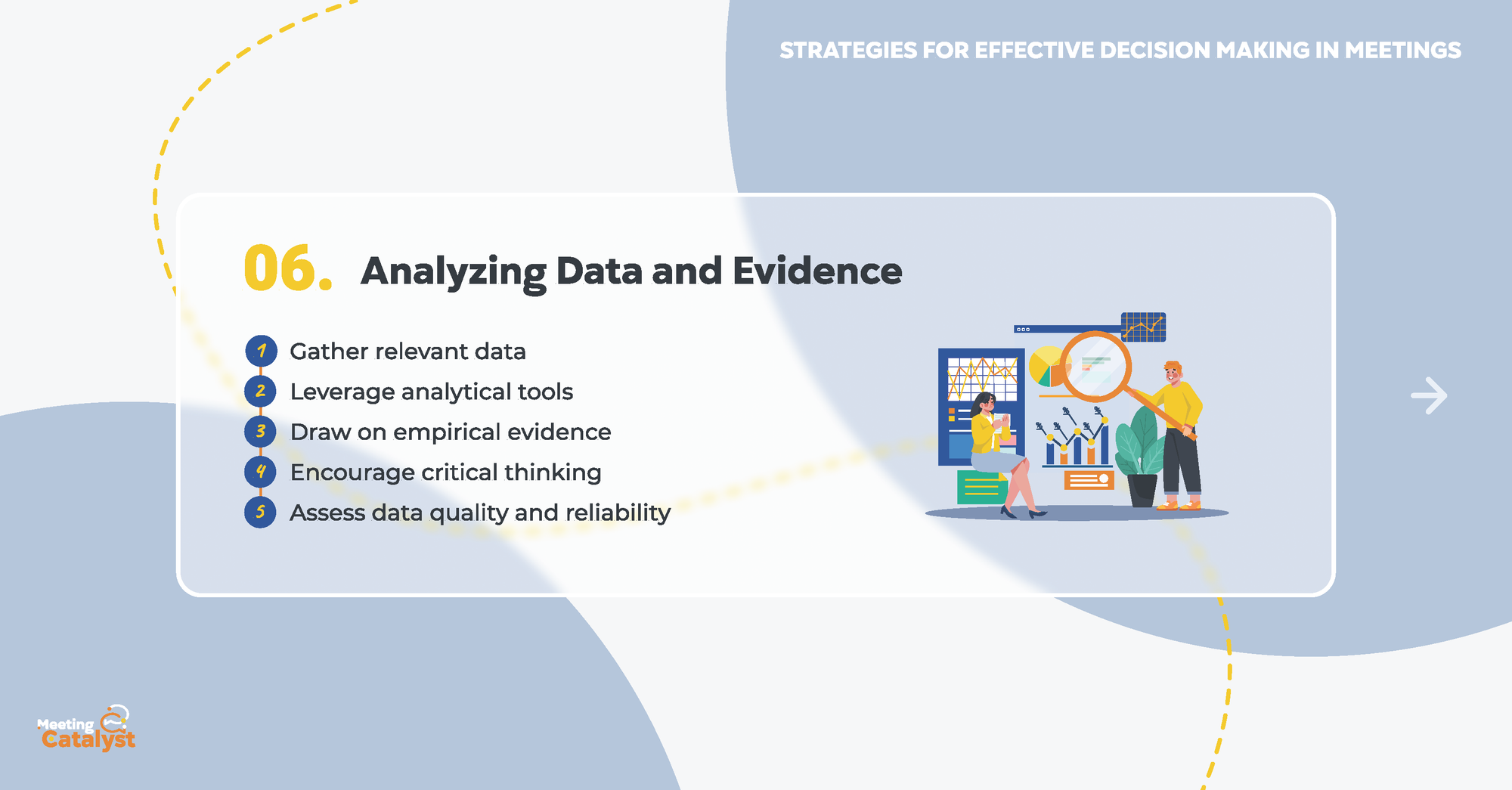
The Role of Data and Evidence Analysis in Effective Decision-Making
Analyzing data and evidence plays a crucial role in supporting effective decision-making in meetings. By examining relevant data and drawing on empirical evidence, decision-makers can make more informed choices that are grounded in objective information. This approach reduces the influence of biases and subjective opinions, leading to better-quality decisions that are more likely to yield positive outcomes for the organization.
Specific Strategies for Analyzing Data and Evidence in Decision-Making Meetings
To effectively analyze data and evidence in your decision-making meetings, consider implementing the following strategies:
Gather relevant data: Collect data from internal and external sources that pertain to the decision at hand, ensuring that the information is accurate, reliable, and up-to-date.
Leverage analytical tools: Utilize analytical tools, such as data visualization software, spreadsheets, or statistical analysis packages, to process and analyze the data effectively.
Draw on empirical evidence: Review existing research, case studies, and industry best practices to inform your decision-making process, providing valuable insights and lessons learned from others' experiences.
Encourage critical thinking: Foster a culture of critical thinking in your meetings, encouraging participants to question assumptions, challenge conventional wisdom, and consider alternative perspectives.
Assess data quality and reliability: Evaluate the quality and reliability of the data and evidence being used in the decision-making process, considering factors such as source credibility, data accuracy, and potential biases.
By incorporating data and evidence analysis into your decision-making meetings, your organization can make well-informed, objective decisions that support its strategic goals and objectives. These strategies will help you harness the power of data and evidence to drive better decision-making outcomes and enhance your organization's success.
Addressing Conflict and Reaching Consensus
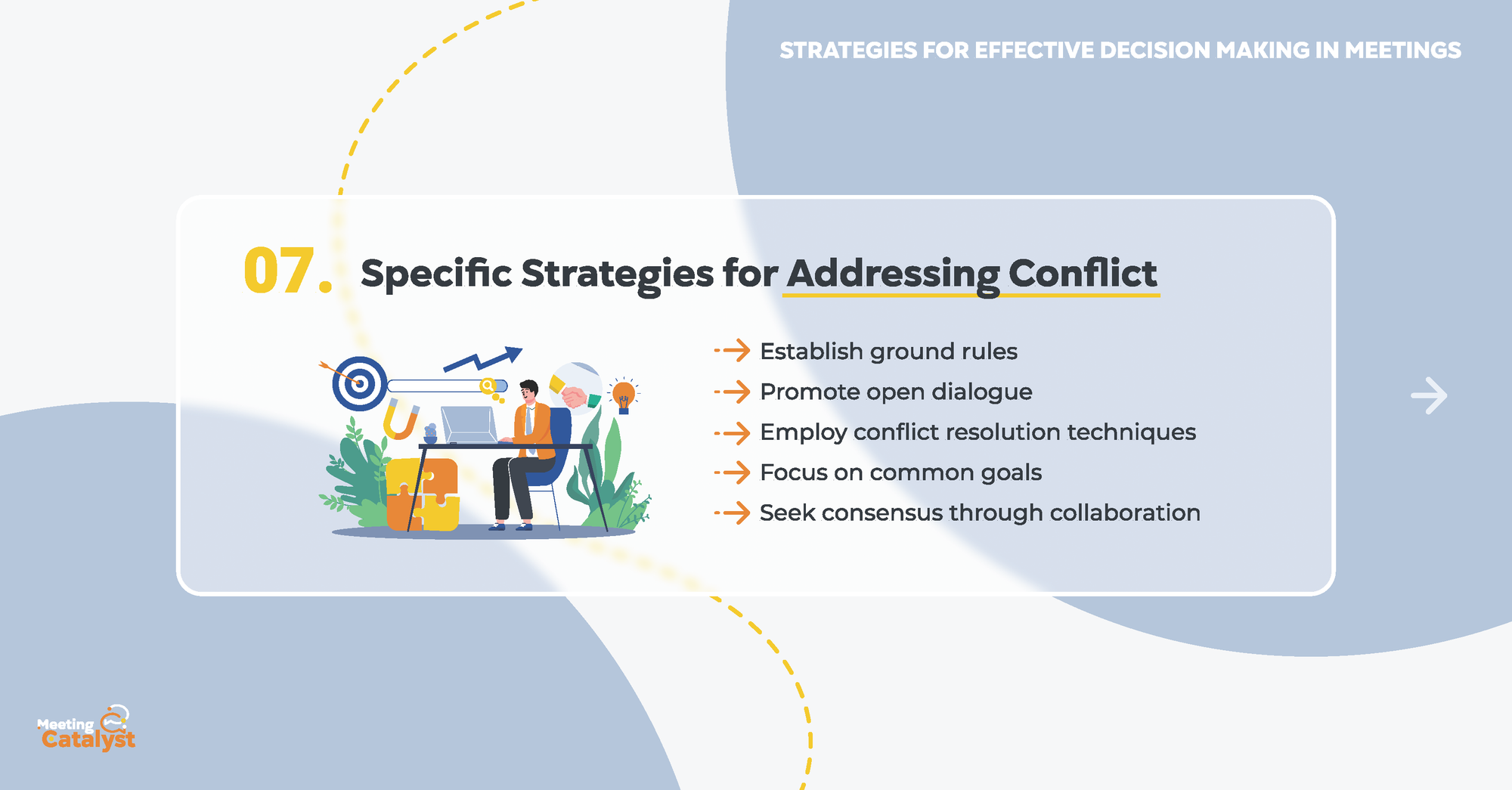
The Importance of Addressing Conflict and Reaching Consensus in Decision-Making Meetings
Effectively addressing conflict and reaching consensus in decision-making meetings is essential for fostering collaboration and ensuring that decisions are widely supported. By resolving disagreements and building consensus, decision-makers can create a unified vision, promote buy-in, and enhance the likelihood of successful implementation of the chosen course of action.
Specific Strategies for Addressing Conflict and Reaching Consensus in Decision-Making Meetings
To address conflict and reach consensus in your decision-making meetings, consider implementing the following strategies:
Establish ground rules: Set clear expectations for meeting conduct, including respectful communication, active listening, and open-mindedness, to create a constructive environment for resolving conflicts.
Promote open dialogue: Encourage participants to express their concerns and ideas, fostering an atmosphere where differing opinions are valued and considered.
Employ conflict resolution techniques: Utilize conflict resolution techniques, such as mediation, negotiation, or the use of a neutral facilitator, to help participants navigate disagreements and find common ground.
Focus on common goals: Remind participants of the shared objectives and values that underpin the decision, emphasizing the importance of collaboration and compromise in achieving these goals.
Seek consensus through collaboration: Strive to reach consensus by incorporating diverse perspectives, generating alternative solutions, and engaging in collaborative problem-solving.
By effectively addressing conflict and reaching consensus in your decision-making meetings, your organization can foster collaboration, enhance buy-in, and increase the likelihood of successful decision implementation. These strategies will help you navigate disagreements and build consensus, creating a strong foundation for your organization's future success.
Conclusion
Reiterating the Importance of Effective Decision-Making in Meetings
Effective decision-making in meetings is crucial for the success and sustainability of any organization. By employing the strategies outlined in this article, you can enhance the quality, efficiency, and inclusivity of your decision-making processes, leading to better outcomes that align with your organization's goals and values.
The Importance of Implementing Effective Decision-Making Strategies
Adopting and implementing effective decision-making strategies can have a transformative impact on your organization, leading to more informed decisions, increased collaboration, and greater adaptability in the face of uncertainty. By putting these strategies into practice, your organization will be better equipped to navigate complex challenges and seize opportunities for growth and success.
Final Thoughts and Recommendations
Investing in the development and refinement of your organization's decision-making processes can yield significant benefits. By understanding the decision-making process, establishing clear objectives and agendas, encouraging diverse perspectives and active listening, implementing a structured decision-making process, assessing risks and consequences, analyzing data and evidence, and addressing conflict and reaching consensus, your organization can make well-informed decisions that drive success and support long-term sustainability.
As you embark on the journey to enhance your organization's decision-making capabilities, remember that continuous improvement is key. Reflect on your decision-making processes, learn from your experiences, and adapt your strategies as needed to ensure that your organization remains agile, responsive, and well-positioned to thrive in the ever-evolving business landscape.